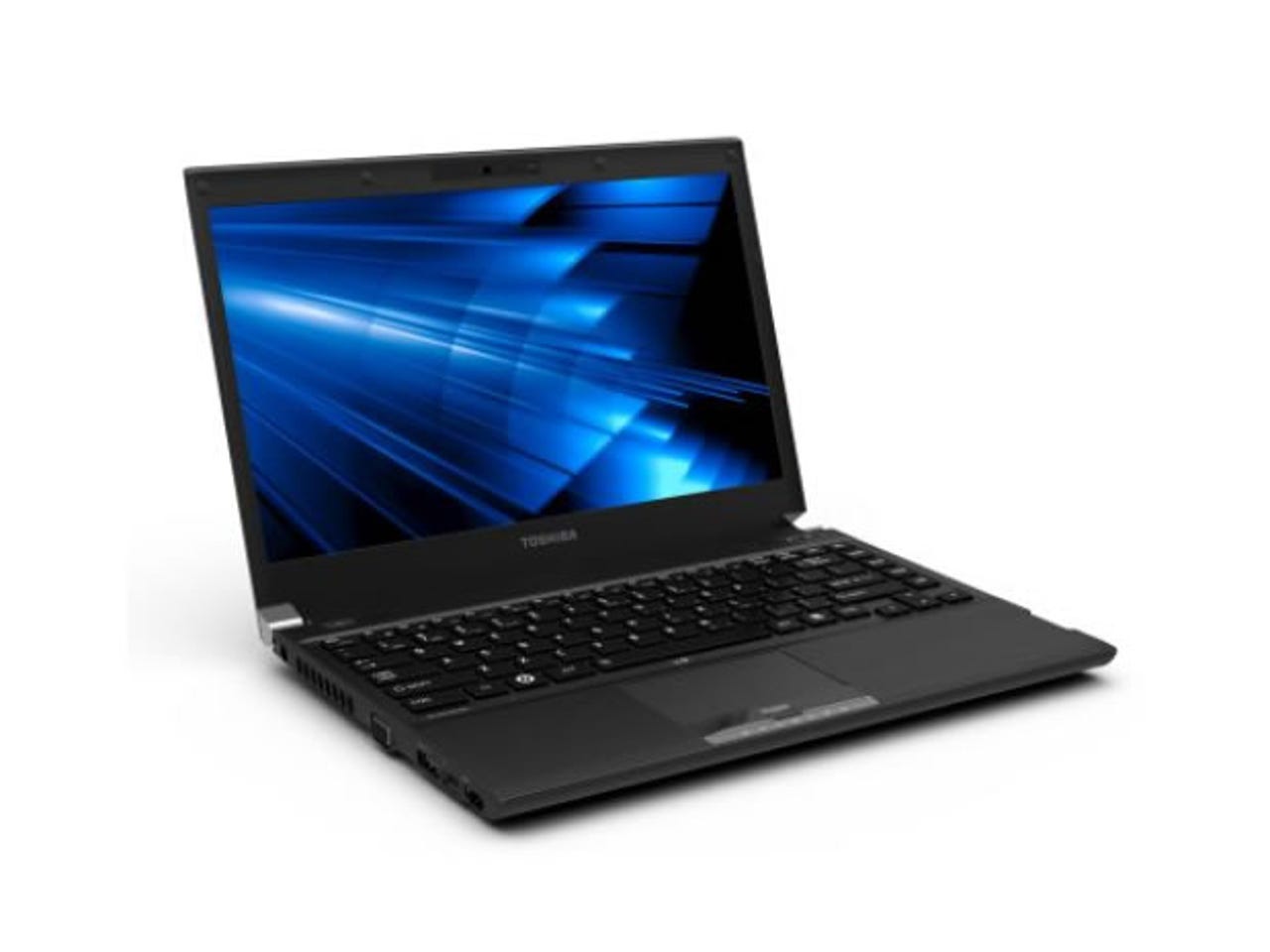Toshiba Portégé R700-15Q


Toshiba's Portégé R700 updates the R600, which we reviewed over 18 months ago. That's a long time to wait for an update to a generally excellent little ultraportable notebook. One notable complaint was that, as with 2007's R500, the R600 suffered from poor battery life. Toshiba claims up to nine hours of battery life for the R700, though, so has that barrier finally been overcome?
The Portégé R700 comes in several configurations, starting with the entry-level Core i3-based R700-15Q (£629 ex. VAT), reviewed here. There are currently seven other models, culminating in the Core i7-based R700-155 (£1,299 ex. VAT).
Toshiba's 13.3in. Portégé R700 range includes Core i3-, i5- and i7-based ultraportables weighing between 1.28kg and 1.43kg
Design
The R700's chassis is neat and stylish, with a lightly brushed-metal look to the black magnesium lid, and a tapering front. There's a little more give in the lid than we'd like, and no clasp between the lid and the main body of the notebook. You'll need a good-quality case of some kind to keep this notebook well protected when you're travelling.
Our review sample weighed 1.28kg. The weight rises as you ascend the price range and add components, topping out at 1.43kg. The R700's 31.6cm-by-22.7cm footprint doesn't change as you move through the range, but the minimum thickness rises from 1.68cm to 1.83cm for configurations with a double-layer optical drive. Whatever model you choose, then, this is a compact and lightweight notebook.
Like many current ultraportables and netbooks, the Portégé R700 uses a 'chiclet'-style keyboard
Inside, Toshiba has followed the current trend for 'chiclet'-style keyboards. The key action is very light and will probably suit long-time touch typists best. We found it comfortable, but others may bemoan its lack of response.
The number row is topped by a slightly squashed row of Fn keys. The 'inverted-T' arrangement of cursor keys is in its usual location to the lower right of the QWERTY keys, but no secondary functions are offered here.
One of the Fn keys locks the touchpad out, and this function is duplicated by a very small button sitting beneath the space bar. Two buttons to the upper right of the screen offer quick access to an external monitor and to the Toshiba Eco Utility, which helps you conserve battery life.
The touchpad itself is large and responsive. There are scroll zones along its right and bottom edges. A rectangle beneath the touchpad is made from a shiny plastic that looks odd next to the matte finish of the rest of the chassis; like the chrome hinges, this design touch looks out of place. It houses the mouse buttons, fingerprint sensor and, along the very bottom, indicator lights that are visible when the notebook is closed.
The 13.3in. non-reflective LED-backlit screen has a native resolution of 1,366 by 768 pixels (16:9 aspect ratio). Viewing angles are good, especially on the horizontal plane. The screen is crisp and sharp too, making it possible to work with two documents opened at once and quite small text on display — if your eyesight is up to it!
Features
There are currently eight different Toshiba Portégé R700 models. Our review sample was the entry-level 15Q configuration costing £629 (ex VAT). The top -end 155 model costs £1,299 (ex VAT).
All variants run Windows 7 Professional 32-bit and come with a DVD_based downgrade to Windows XP Professional. Our review sample had a 2.26GHz Intel Core i3-350M processor and 2GB of RAM. Three of the models come with 4GB of RAM, while more powerful processor options include a 2.4GHz Core i5-520M and, in the most expensive model, a 2.66GHz ="http: ark.intel.com="" product.aspx?id="43560"">Core i7-620M. In all cases graphics are managed by Intel's CPU-integrated HD Graphics.
Hard drives vary little across the range: all but the most expensive configuration have a shock-protected 320GB drive, while the top-end model uses a 128MB SSD. All models offer Gigabit Ethernet, Wi-Fi and Bluetooth, and four of the eight models add in mobile broadband too.
If you want an optical drive you'll need to look at the £779 (ex. VAT) Portégé R700-15U, and if you want a double-layer optical drive then you need to go further up the scale. The optical drive, if present, sits on the right edge of the chassis. Some models, although not our entry-level unit, also have an ExpressCard slot.
Ports and connectors are a little limited. The right-hand side houses a card reader for SD and compatible formats, a pair of audio jacks, a single USB 2.0 port and the Ethernet (RJ-45) connector. The front and back are clear. The left side houses an HDMI port, a second USB 2.0 port, a combined eSATA/USB port with sleep-and-charge for USB devices, a VGA port and the power connector.
You can use the R700's webcam for face-recognition-based login
There is a VGA-resolution web camera above the screen and, as usual with Toshiba notebooks, when you put the cursor on the left edge of the screen a menu pops out that lets you run the camera software. You can use the camera for face-recognition-based login, and can put a small selection of frames around an image.
Toshiba provides its now-familiar Bulletin Board application, which allows you to gather shortcuts to documents, widgets and notes in one place. The company's ReelTime service provides a thumbnail-based timeline of recently accessed files.
Toshiba's power-saving Eco Utility in action
You also get Toshiba's Eco Utility, which monitors the system power usage and allows you to quickly switch into a energy-saving mode to conserve battery life.
Performance
The R700-15Q's Windows Experience Index (WEI) of 4.0 (out of 7.9) isn't stellar, but the overall rating is actually the score for the lowest-performing component — which in this case is the lowest performing by some margin. The score of 4.0 went to Graphics (desktop performance for Windows Aero).
The remaining scores are much more respectable: 5.1 for Gaming Graphics (3D business and gaming graphics performance), 5.5 for Memory (RAM Memory operations per second), 5.9 for Primary hard disk (Disk data transfer rate) and 6.2 for Processor (calculations per second).
As far as battery life is concerned, Toshiba claims just under 9 hours (8 hours 55 minutes) for all models except the most expensive Corei7/SSD-equipped model, which has a rating of 8 hours 10 minutes. To test this we selected the Eco power plan, turned Toshiba's Eco Utility on and (in the absence of an optical drive) played video from a USB stick for as long as possible. We got video playback for 4 hours 12 minutes under these conditions, which is very good indeed.
The audio subsystem delivers reasonable volume but moderate quality. That's par for the course for a business notebook, and the volume is good enough to deliver a presentation with audio to a small group direct from the notebook.
If you like to work with a notebook on your lap for extended periods, then it's worth noting that the left edge, by the cooling vent, got quite warm. There's no cause for concern regarding the notebook's viability, but your left leg may get get a bit warm after a while.
Conclusion
Toshiba's Portégé R700 is a well-made 13.3in. ultraportable whose only significant issue is a rather flexible lid section. Some users may find the keyboard too spongy for their liking, and you'll have to move up the range if you want an integrated optical drive. Battery life is good, though, and that could be enough to tip the scales in the R700's favour.